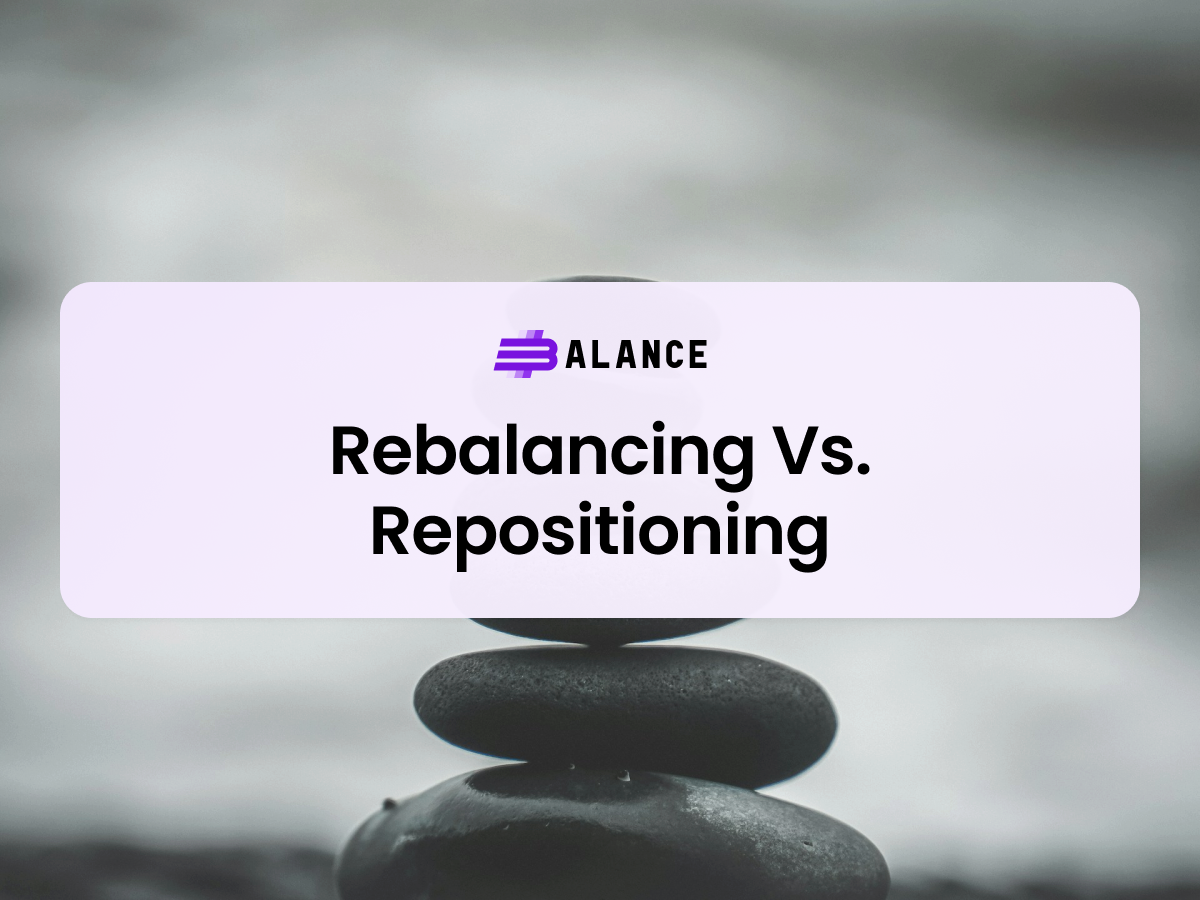Rebalancing and repositioning may sound similar, but they serve very different purposes when it comes to managing your crypto portfolio. Knowing the difference between these methods will help you maintain a strong portfolio as the market—and your skills, interests, and knowledge—change over time. We’ll cover everything you need to know about rebalancing vs. repositioning, including when to consider using each, the easiest way to do it, and what to look for when considering repositioning.
Let’s go!
What’s What?
Crypto Portfolio Rebalancing
Rebalancing is about maintaining your portfolio's intended allocation over time. It ensures your portfolio stays aligned with your original investment strategy and is triggered by deviations in your asset allocation due to market movements. The overarching goal is to avoid overexposure to any single asset while staying within your risk tolerance.
Crypto Portfolio Reposition
Repositioning is about strategically changing your portfolio’s structure to reflect new goals or market trends. Generally, traders reposition when there’s a change in their investment strategy, the market conditions, or their personal goals. You will remove, add, or reallocate assets in your portfolio.
3 Key Differences
- Frequency
Rebalancing is done regularly, whereas repositioning happens as needed. - Purpose
Rebalancing is meant to keep you aligned with your existing plan, while repositioning reflects a change in strategy. - Action
Rebalancing is simply tweaking your percentages. Repositioning may involve adding or removing assets entirely.
How to Decide Which Strategy to Use for Your Crypto Portfolio
Deciding between methods depends on your investment goals, market conditions, and personal circumstances.
Here’s how to determine which is best for you at the moment:
- Evaluate Your Goals
If you want to stick to your existing strategy, maintain a consistent portfolio, or are confident in your current asset mix, rebalance to correct for market drift. If your investment goals have shifted, you want to capitalize on new trends, reduce exposure to underperforming sectors, or are excited to try a new strategy—reposition. - Analyze Market Conditions
If, during market volatility, you want to maintain your original allocations (and maybe avoid emotional trading!), try rebalancing. You’ll correct for shifts in your asset values without making significant changes to your portfolio structure. However, if the market trends indicate a long-term opportunity or risk that is not part of your initial plan, reallocate to make space for the new development. - Assess Your Portfolio’s Performance
Have an asset mix you believe can achieve your goals? Rebalance to keep your portfolio aligned with your original strategy. If certain assets have consistently underperformed and you no longer believe they fit your strategy or you’re ready to diversify further, reposition. - Consider Your Investment Horizon
Rebalancing is great for long-term investors aimed at steady growth. If that goal has shifted for you, you can test out reallocating based on new market insights, personal priorities, or because you’re now an active investor looking to optimize for changing conditions.
Found An Asset Worth Repositioning For? Read This:
Adding new tokens to your portfolio can be exciting! It’s a great way to capitalize on emerging narratives and macroeconomic trends. Remember to always do your research before investing. Here’s what we consider before reallocating for an exciting new asset:
**What’s The Narrative? **
Understanding what’s driving the trend is key. Look for how sustainable the trend is and distinguish between hype and long-term potential. It’s also important to look at who’s behind the project. Look for assets supported by credible projects.
**What’s The Macro Context? **
You want to consider items like market cycles, regulatory landscapes, and global economic trends. Upcoming regulations often impact tokens and sectors, as do interest rates, inflation, market phases, or global events.
Look At The Token Itself
Things to keep in mind include the utility and use case, the community and adoption to indicate long-term growth and potential, and the overall tokenomics. Beware of unsustainable rewards or highly centralized supply!
Think About How It Fits Your Portfolio
Consider testing your new asset with a small allocation at first. You’ll want to consider how it shifts your risk vs. reward and the diversification of your portfolio.
Don’t Trade Emotionally
Avoid acting out of FOMO or hype! Instead, monitor the asset and enter when the price has stabilized or the initial excitement has subsided. You can consider a DCA strategy here to build your position gradually and minimize your exposure to volatility.
Key Questions to Ask Yourself Before Adding a Token
- Does this align with my investment goals and risk tolerance?
- What problem does the token solve, and how is it positioned to succeed?
- Is the token gaining traction among major players in the space?
- How does this token diversify or strengthen my portfolio?
Tools That Help
The crypto world is full of helpful new developments, and there are plenty of tools that can help you decide between rebalancing and repositioning—and then execute the trades! For example, 3Balance is a tool that helps you monitor your portfolio’s performance across wallets and chains and visualize what it would look like with different allocations or by adding and removing assets.

Try 3Balance for rebalancing now, it's free!
Manage your crypto portfolio like a Pro: set up your ideal allocations, swap multiple tokens in one flow and much more. Check it out!

